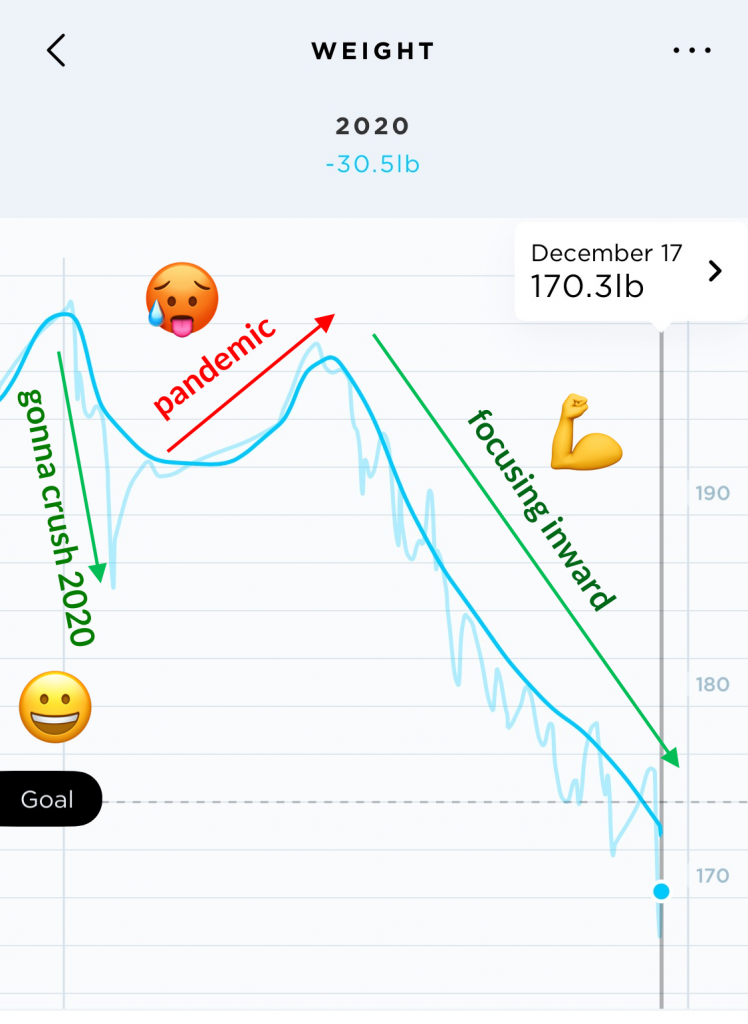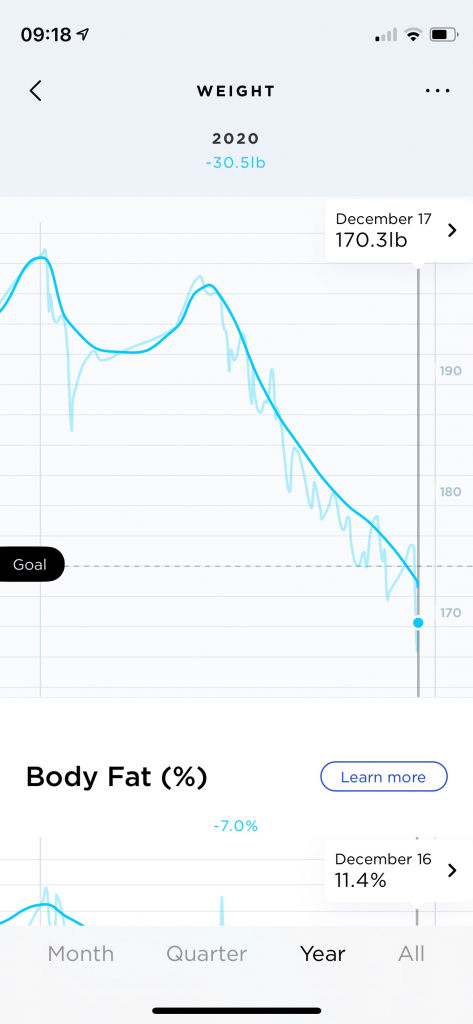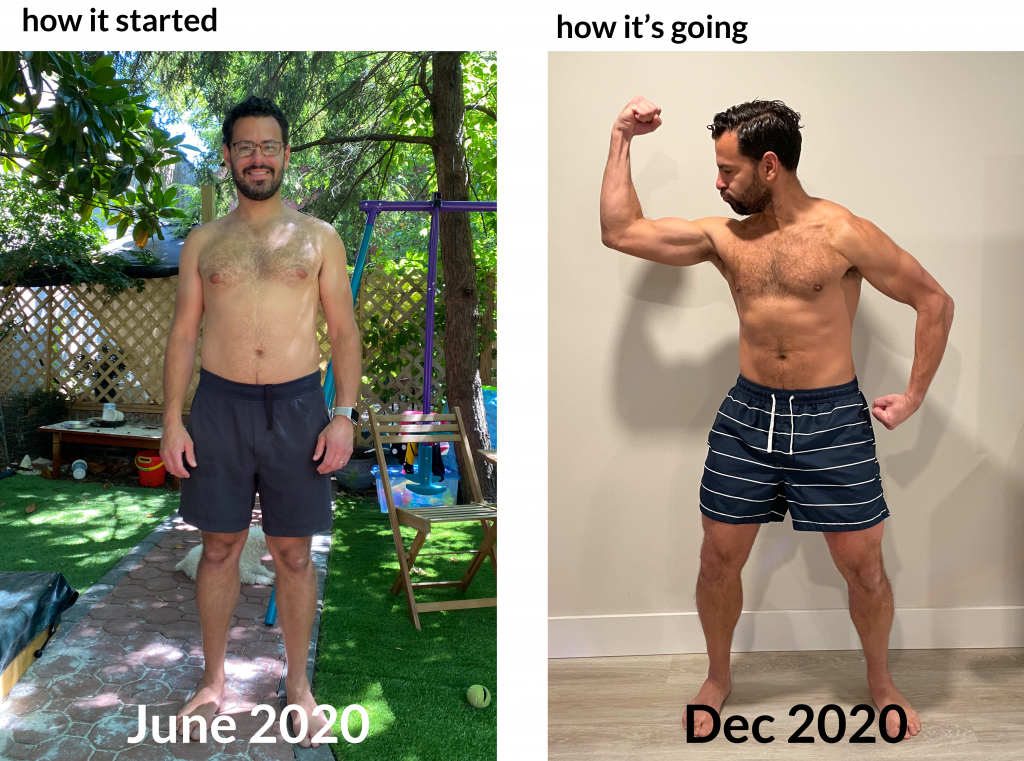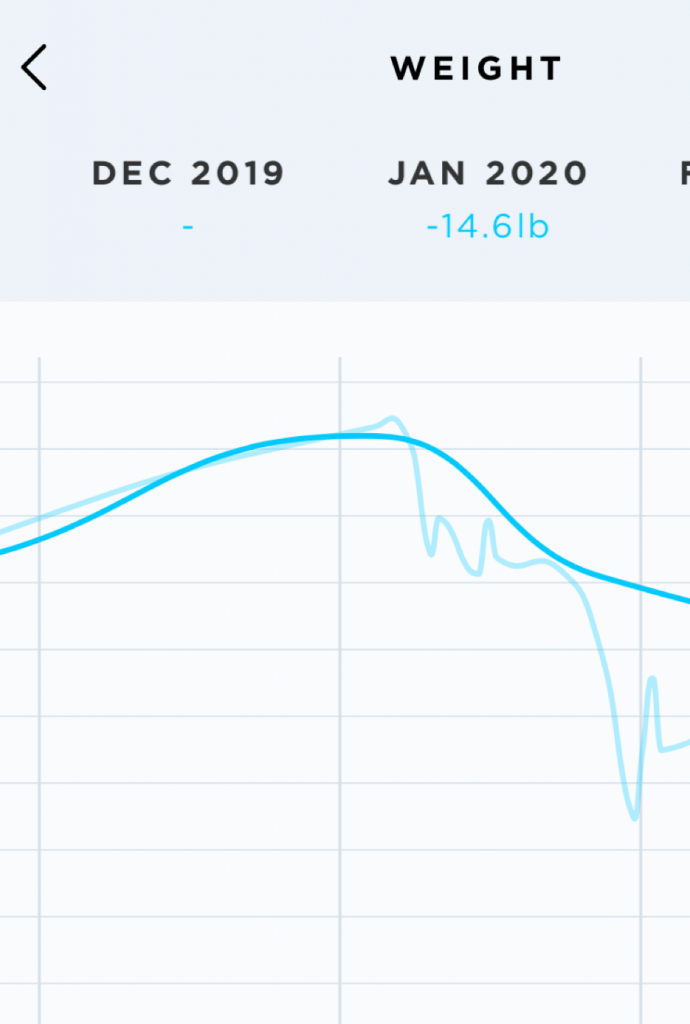
2020 has been a year like no other, a roller coaster. I dealt with the stress probably like most of you – in March and April I pretty much stopped working out, was stress eating, and drinking more alcohol than I wanted. It really was such a crazy period, frustrating because of how much was outside our control, how our routines were up-ended, and there was just SO MUCH uncertainty about the future.
It was frustrating because there was so much that was out of my control. I’m not a doctor or politician or social worker, so there weren’t many levers I could pull. This frustration was also somehow freeing. So amidst all these these uncertainties, I turned inward. Focusing on what I actually COULD control: my family, my mind, my body, my soul. In particular I found focusing on the body as a foundation and flywheel that helped empower other positive trends and habits, and a great way to break the negative cycle I was in.
The following is a detailed post of what changed in the last 7 months of 2020. It’s long and personal, but hopefully also skimmable if you want to jump to the juicy bits, and maybe helpful when creating 2021 resolutions.
TLDR: How I lost 30 pounds in 7 months and built a foundation for longevity


My 3 step process
Here’s the simple cheat sheet of my habits over the past 7 months that led to losing 30 pounds in an almost straight line of losing about 1 pounds per week (almost all of that in fat). They are outlined in the order that I started layering them in, and each build nicely on each other.
0 – Research foundation
My plan was based on fasting, keto, and more working out, and I did a fair amount of research to create it, mainly deep dive into Peter Attia’s AWESOME podcast, plus the Ketogenic Bible. These two helped crystallize and motivate the plan below.
1 – Fasting
1a: Time Restricted Feeding: (TRF, aka Intermittent Fasting): Starting at 18 hours, then built up to a baseline of 20-22 hours fasting per day (basically one meal a day and some grazing). TRF is was a great way to cut late night snacking and stress eating. This in turn helped set up a foundation for:
1b: Multi-Day Fasting: I did a 3 day fast once per month from June through December, and will continue in 2021. During these long fasts, I drink only water, black coffee, and tea. In addition to the massive health benefits of fasting, this also helps train my body to more easily transition into ketosis, which in turn makes me want to stay in nutritional ketosis (e.g. you’re still in ketosis even while eating regularly), with in turn set up the foundation for:
2 – Keto diet
Once I experienced the keto high in my June 3-day fast, I wanted to continue maintaining that. So I switched to a primarily keto diet – the easiest way to do this is basically to cut sugar, fruit, carbs. It sounds bad, but there’s lots of amazing and tasty stuff to eat on keto. Plus, after just 2 weeks your sweet tasting taste buds recycle, so you can essentially re-calibrate your sweet tooth, and switch to things like nuts or 70-90% dark chocolate for dessert (or awesome keto desserts, more later). Diet was definitely the foundation for the weight loss, then I could layer in working out, starting with consistency.
3 – Working out
3a: working out consistently (5x weekly): This has been one of the hardest parts of my health goals over the last 4 years with kids. It’s hard to find time consistently when you’re not sleeping, and childcare takes up what little time you do have. Luckily a) the habits above don’t take any time so you can start whenever, and b) I was lucky enough with our youngest turning 1 I could prioritize working out. The first step was to simply work out consistently, then I could layer in volume.
3b – Working out smarter: once the habit was established, I could explore the routine that worked best for me, and settled on 5x per week of the following:
- 2x weekly running (~7 miles each, pretty light, Zone 2)
- 2x weekly strength training (usually heavy compound lifting plus stability)
- 1x soccer or HIIT (~2 hours soccers or HIIT when I couldn’t do that)
Once the flywheel got going, it was surprisingly easy to maintain these habits.
Given that I was trying to lose weight while raising 2 kids under 4, running a VC backed tech startup, and living through a pandemic, the plan had to be simple and sustainable. The last 6 months (losing 25lb) was like rolling down hill because the patterns were established and helped reinforce each other. If this was HARD, there is ZERO chance I would have been able to achieve it with everything going on in 2020. And now heading into 2021 I’m confident in being able to maintain most of these steps and maintain weight.
My previous health baseline: a ~decade of accumulated “health debt”

I’m turning 40 in 2021, have 2 kids, and an intense job running VC backed startup. My body and fitness habits are probably similar for most folks in that situation. It’s just so easy to ignore health as life gets in the way, and the decay continues. Over the years, especially throughout your 30s, it’s easy to let your diet get worse and your exercise habits fall off, and this is exacerbated if you have kids! Similar to “tech debt”, you’re essentially taking a line of credit on your poor health habits to do other things (have fun, work harder, manage stress, etc.), but at some point that health debt is going to come due.
Here’s where I was at the start of 2020
- Pretty stereotypical dad bod. Not fat per se, but soft, a small belly, weighing a stout 200 lb on a 5’9″ frame.
- Hadn’t lifted weights or squated in 5+ years
- Working out about ~2 times per week (1 soccer, 1 ~3-5 mile run)
- Diet: would try and eat healthy, but also had a nice sweet tooth and snacking habit after dinner. About 10 years ago I had experimented with keto and paleo, but never for a long time.
- Fasting – had never tried intermittent fasting or long term fasts.
- Drinking alcohol maybe 3-5 times per week, 3-5 drinks per time (wasn’t tracking it in detail), so easily 15-20+ per week. On one hand it sounds like a lot, on the other hand ~2 per day for men is the recommended max according to the CDC, and about the dose that most studies show has minimal health impact and even sometimes is better than fully abstaining (though there’s probably a lot of confounding factors in that specific trend).
Overall these stats disappointed me, and I knew that over the long term they were definitely unhealthy habits that I needed to correct.
And to make matters worse, 2019 was a particularly challenging year for health with the birth of our second child. Heading into 2019 I knew I wouldn’t be able to do much to invest in health given crappy sleep, newborn stress, lack of time. And my personal 2019 goal was scoped to match: “survive”. But this meant my health debt was accumulating.
2020 – A roller coaster year
2020 Goal: focus on health and longevity, start paying off that “health debt”
Having survived 2019, I went into 2020 with the goal to really invest in my health. This was motivated by the slow decline in health I mentioned above, the looming 40th birthday (coming in 2021), a desire to be healthier (and live longer) for my kids, and an intellectual understanding that investing in health would have tons of positive benefits.
Additionally, at the end of 2019 I was turned onto Peter Attia and his amazing “The Drive” podcast (thanks Dan Scholnick!). Peter Attia is a well known guru on focusing on improving and extending health span and lifespan. I went really deep into his content, and used that information both the motivation for improving health, AND help creating a playbook (fasting, keto, exercise framework, etc.). I can’t recommend that podcast highly enough, changed the trajectory of my life.
Starting off strong

I kicked off 2020 with a strong January: no drinking, healthy eating, 18 hour intermittent fasting, and closed January with a 5 day water only fast. I lost ~10 pounds, was working out a bit more, and felt like I was well on my way to cruising towards my health goals in 2020. But…
Curve-ball: the pandemic hits and undoes ALL progress
I’m probably not alone in admitting that my 2020 health goals went completely out the window in March and April. So much stress, so much unknown, routines destroyed, uncertainty with big and small things. My diet went to crap, I used food and alcohol to help calm my nerves, and just couldn’t be bothered to maintain discipline as the world burned.

By the end of May I was back to where I started, about 200 pounds. My awesome January totally undone.
Focusing inward and re-committing to health
At Memorial Day I decided to re-commit. The new routines of pandemic life had stabilized, and I found it really helpful to be able to focus inward among all the uncertainties. To focus on what I COULD control, when there was so much I couldn’t. The health motivations that I started the year with didn’t go away, but it was too hard to prioritize them in March and April.
So starting in June I started building up the foundation again, layering in diet, fasting, working out, and by the end of June I had established enough of a routine that I could see the goal clearly, totally achievable, just needed to stay on plan.
Learnings + Observations + Recommendations
What would a post like this be without some unsolicited advice! Here’s some observations I found.
Goals are useless without a consistent + achievable plan to get there
The difference this year and the previous years that I had a “goal” to get to 180 lbs but failed, is that I had a very deliberate process. About 30 days of consistently following this (in June after Memorial Day), it was clear to me that this was a sustainable approach to lose ~5 pounds per month. Even though I was just starting down the path, I could clearly see that I’d hit my goals (and more) in about 6-7 months, and sure enough the weight loss followed EXACTLY that pattern established in June.
A great book on this is Atomic Habits by James Clear.
It’s easier to build habits incrementally
Intermittent fasting is great prep for multi-day fasts, which in turn is a great way to segment into keto diet. Taking January off of drinking is a great way to step towards drinking less in general. Running twice per week is a great step towards running 3 times per week. It sounds obvious but the steps really do build.
Positive habits create a flywheel
Over the course of the year it became easier to layer on more good habits because I had been building the habit muscle, got positive reinforcement along the way, and the habits in turn support each other. For example Journaling I added as I got deeper into meditation (inspiredy by Stillness is the key), which in turn reinforces meditation and working out, as I journal the positive accomplishments of my fitness and meditation practice. All the physical and body related activites massively support each other. Working out helps you sleep better, clears your mind, makes you WANT to eat better. Cutting out junk from my diet makes me want to cut junk out from everything else, etc.
The corrollary is also true – negative habits reinforce each other. When you drink too much, you sleep MUCH worse, feel shitty in the morning, you’re less likely to want to meditate, more likley to eat like crap to maybe help you feel better, less likely to work out, and more likely to want another drink that night.
Try Dry-January
I started doing this in 2016, and it was a great wake up call to the amount of alcohol we accept as pretty normal in our normal society. The first time you do this if you’re an adult who might not have taken more than a week off since before college (this is surprisingly common), it’ll be difficult, but power through.
After not eating junk or sugar, “normal” and healthy stuff tastes AMAZING
A famous Stoic philosopher Diogenes noted that we “greatly enhance our appreciation of any meal by waiting until we are hungry before we eat it and greatly enhance our appreciation of any beverage by waiting until we are thirsty before we drink it.” (from A Guide to the Good Life) He said this before keto was a think, and it’s timeless.
After about 1-2 months of consistent healthy eating and fasting, I found myself really LOVING foods that otherwise would have been bland. Unsalted nuts, plain (full fat of course) yogurt, even water! I always liked these, but after cutting sugar and junk, I now really loved eating these foods.
Keto diet is easier to follow than you think
Keto is often mis-understood, confused with Paleo, dismissed as a fad.
But the science behind it is great. Not to get all preachy, there’s plenty out there on keto. For me the main idea that helped me truly “grow” keto was the glycogen vs keto based energy system.
Our default energy source is glycogen (sugar), which is readily available in the blood. The problem is that this source only has about 2,000 calories in a given time, and is subject to wild swings due to insulin response, creating hunger pangs (e.g. “hangry”), variations in energy levels. And over the long term can create metabolic disorders like diabetes.
The alternative energy source is fat. We have 40,000+ calories of fat stored in our bodies. But this is typically not as accessible as blood sugar, so we simply store it. We CAN access this when we deplete our glycogen stores. When we do, it’s called being in “ketosis”, when our body switches to burning fat for energy, and creating “ketones”. If you deplete your ~2k glycogen energy stores (about 24 hours), your body will switch into ketosis. But there’s a catch. The first few times you’re doing this it might feel shitty. Your body hasn’t really been tuned for this, so you might be groggy or have the keto flu. But once you do get there, you’ll probably get a keto high (see next point). You can get into ketosis with a strict keto diet (nutritional ketosis) but this can be hard (VERY low carb AND protein). But long term fasts will definitely get you into ketosis, and also more likely to get that high.
Keto high is real
If I can point to a SINGLE thing that helped it all fall into place, it was the keto “high” I felt after my 3 day fast in June. After 3 days of eating, not only was I not hungry, I felt AMAZING. My mind was clear, I had plenty of energy, I felt calm, and all these feelings were smooth and consistent throughout the day – not the typical highs and lows. This feeling was (from my understanding) my body being in pure ketosis – using ketones for energy across the body and brain.
That keto high motivated me to keep maintaining it, to keep chasing it. Plus it Made it really easy to maintain the pace I was at. It was that moment that I knew I could sustain the plan for 6-7+ months, because actually IT WASN’T HARD.
It wasn’t a diet that made me feel hungry and shitty, I actually felt better, and I knew my body was getting healthier as a result .
Keto desserts are amazing (and a nice release valve)
You can make super tasty keto desserts with various combinations of coconut or almond flour, eggs, butter, allulose or erythritol, cocoa powder or unsweetened chocolate, and nuts. These desserts are very satisfying, and portions self-regulate because of the fat (vs fructose which makes you eat more of it).
I really like this book: Keto Fat Bombs, Sweets and Treats, though also plenty of recipes online
Long term fasts promote mindfulness and appreciation
When you don’t eat for 3 days, you realize a lot about your relationship with food that you took for granted. It’s a bit like DFW’s “What is Water” speech – you go your whole life eating every ~8 hours or less, that when you go 72 hours without eating, you realize just how much of that eating was not because you were hungry, but because you were bored. So on a long term fast those mindless moments of looking for a snack turn into a nice opportunity for introspection: why did I really open this fridge?
On the other side of the extreme, there are times during a long term fast that you’re actually pretty hungry (this goes away). So on that side of the spectrum you can be mindful about appreciating food that you might usually take for granted, and you can imagine how even a single bit of a normal food (cheese, broccoli), would just taste SO good right now (during your fast), but usually you either scarf it down without thinking or turn down perfectly healthy and tasty food for options that might be more indulgent but ultimately less healthy (and was that indulgence needed).
These observations of us taking food for granted, appreciating hunger, realizing the real motivations for eating, are also coupled with a somehow more alert mental state, creating a nice calm introspective mindfulness in my experience.
Fasting feels like a cheat code
Fasting intermittently (< 20 hours) or multi-day is a really easy way to get to your health goals. 16 or 18 hour fasts are good to stop late night snacking, and to build incrementally towards longer fasts. And longer fasts are a great way to get into ketosis. As I mentioned before, all these habits tend to stack. Here’s my full year of fasting habits, where you can see my solid January, falling off the wagon during the pandemic, then the consistent Jun to December with mainly 18-22 hour fasting daily and one 3 day fast per month.

Get back on the barefoot running train
I first got on the barefoot running training (along with everyone else), when “Born to Run” came out. In fact, it motivated me to switch to Vibram five finger shoes and run an ultra marathon
Then there came the barefoot running backlash, mainly due to a MARKETING issue, which then put a damper on the running shoe companies, and in turn the whole movement.
But it still makes sense. We under utilize our awesome feet, and most running shoes are overly cushioned and stabilized. If you’re interested check out the this great podcast with Irene Davis from Harvard Medical School about current shoes and benefits of barefoot running.
I switched wholesale to Xero Shoes (literally ordered 7 pairs of shoes for all uses.)
Sleep is a critical building block
One of the reasons my 2019 goals were scoped to only “survive” was that I knew I wouldn’t be able to get consistent high quality sleep with our newborn.
But heading into 2020 I wanted to prioritize this. I invested in an Ooler mattress cooler (this helps but not sure exactly how much), and in a more consistent bedtime routine, specifically around tech. I try to not use tech (other than Kindle) ~1 hour before bedtime and 1-1.5 hours after waking up. Studies have shown that even the anticipation of checking email or social media in the morning can ruin your sleep, so I make it a point not to check my phone until at least 1 hour AFTER waking up.
Looking forward to the next four decades
I’ll be turning 40 in 2021. And instead of a “mid life crisis” I’m going to take this somewhat artificial numerical milestone and turn it into a “mid life opportunity”. An opportunity to get and stay healthy, focus on what really matters, and create a great foundation for the next 4+ decades of life.
I’m happy to answer more questions, or if you’ve got clarifications on any of the science above, would love to hear it.
References and Additional Reading
Here’s some of the key resources that helped motivate me and create my plan. First and foremost absolutely was Peter Attia and his podcast. It really catalyzed a lot of my motivation and organized a lot of my understanding of the science behind these trends. Start there, plus see more below:
- Peter Attia Podcast: an incredible resource on health and longevity
- The Ketogenic Bible – great overview of the science and benefits of ketogenic diets, more approachable than the name suggests!
- Atomic Habits by James Clear – great framework for building consistent habits to accomplish big goals in a step by step way.
- Key Technology
- Zero Fasting: Great for intermittent fasting (time restricted feeding), partly for the habit creation and “ceremony” of closing the kitchen, and also nice for journaling longer fasts.
- Less (drink tracking): super simple app that does ONE thing – tracks how many drinks you had. Seems silly but it’s great for the aggregate data and as a mini motivator depending on your goals.
- Fitbod: The best of the bunch that I’ve found for flexible and detailed weight lifting tracking.
- Apple Watch: great way to get consistent long term data on health, including sleep, running, etc.